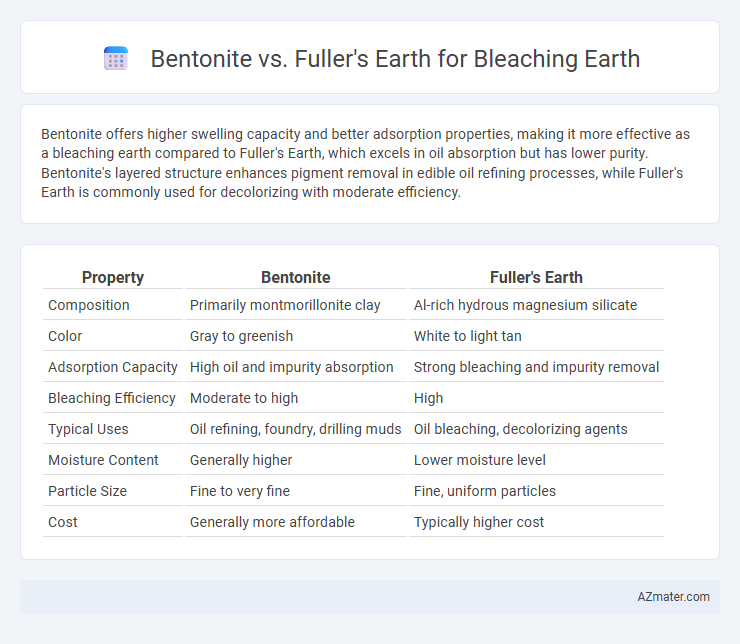Bentonite offers higher swelling capacity and better adsorption properties, making it more effective as a bleaching earth compared to Fuller's Earth, which excels in oil absorption but has lower purity. Bentonite's layered structure enhances pigment removal in edible oil refining processes, while Fuller's Earth is commonly used for decolorizing with moderate efficiency.
Table of Comparison
| Property | Bentonite | Fuller's Earth |
|---|---|---|
| Composition | Primarily montmorillonite clay | Al-rich hydrous magnesium silicate |
| Color | Gray to greenish | White to light tan |
| Adsorption Capacity | High oil and impurity absorption | Strong bleaching and impurity removal |
| Bleaching Efficiency | Moderate to high | High |
| Typical Uses | Oil refining, foundry, drilling muds | Oil bleaching, decolorizing agents |
| Moisture Content | Generally higher | Lower moisture level |
| Particle Size | Fine to very fine | Fine, uniform particles |
| Cost | Generally more affordable | Typically higher cost |
Introduction to Bleaching Earths
Bleaching earths primarily consist of highly absorbent clays like bentonite and Fuller's earth, widely utilized in industrial oil refining processes to remove color pigments and impurities. Bentonite, rich in montmorillonite, offers superior swelling properties and adsorption capacity, making it effective for bleaching oils. Fuller's earth, predominantly composed of palygorskite or attapulgite, provides excellent oil absorption and decolorization but differs structurally and functionally from bentonite in bleaching applications.
What is Bentonite?
Bentonite is a highly absorbent clay primarily composed of montmorillonite, known for its exceptional swelling properties and high cation-exchange capacity. In bleaching earth applications, bentonite effectively removes impurities, pigments, and free fatty acids from oils, enhancing color and stability. Compared to Fuller's Earth, bentonite typically offers stronger adsorption capabilities due to its unique layered structure and chemical composition.
What is Fuller’s Earth?
Fuller's Earth is a naturally occurring clay material composed primarily of hydrous aluminum silicates, known for its exceptional absorbent and decolorizing properties, making it ideal for use as bleaching earth in oil refining. It effectively removes impurities, pigments, and free fatty acids from vegetable oils, enhancing oil clarity and stability. Compared to bentonite, Fuller's Earth typically offers higher bleaching efficiency and greater capacity for adsorbing chlorophyll and other pigments.
Chemical Composition Comparison
Bentonite and Fuller's Earth, both widely used as bleaching earth, differ significantly in chemical composition; Bentonite primarily consists of montmorillonite, a clay mineral rich in silica (SiO2) and alumina (Al2O3), with a notable amount of magnesium and calcium ions. Fuller's Earth contains a higher proportion of hydrous aluminum silicate, often exhibiting a greater content of iron oxide (Fe2O3) and lower magnesium levels, which influences its adsorption and bleaching efficiency. The differing ratios of silica, alumina, and metal oxides in Bentonite and Fuller's Earth directly impact their capacity to adsorb pigments and impurities during oil bleaching processes.
Adsorption Capabilities
Bentonite exhibits superior adsorption capabilities for bleaching earth applications due to its high cation exchange capacity and layered structure, enhancing the removal of impurities, color pigments, and free fatty acids. Fuller's Earth, while effective, generally has a lower surface area and adsorption capacity compared to bentonite, limiting its efficiency in refining edible oils. The clay mineral composition and porosity of bentonite make it more efficient in adsorbing unwanted substances during oil bleaching processes.
Applications in Oil Purification
Bentonite and Fuller's Earth are both clay materials extensively used as bleaching earth in oil purification, primarily for removing color, impurities, and contaminants from edible and industrial oils. Bentonite's high swelling capacity and cation exchange properties make it effective in adsorbing pigments and oxidation products, while Fuller's Earth, known for its high surface area and porosity, excels in decolorizing and detoxifying oils. In applications such as vegetable oil refining and petroleum oil bleaching, the choice between Bentonite and Fuller's Earth depends on the specific oil type, impurity profile, and desired clarity and stability of the final product.
Efficiency in Color Removal
Bentonite and Fuller's Earth both serve as bleaching earth in oil refining, with Bentonite typically demonstrating higher efficiency in color removal due to its superior adsorption capacity and larger surface area. Bentonite's montmorillonite structure allows it to attract and trap pigments more effectively, resulting in clearer, lighter oils compared to Fuller's Earth. In industrial applications, Bentonite often reduces color units more significantly, enhancing the final product's visual quality and market value.
Environmental and Health Considerations
Bentonite and Fuller's Earth both serve as effective bleaching earths, but Bentonite, primarily composed of montmorillonite clay, typically offers superior adsorption properties that can reduce the need for chemical additives, minimizing environmental impact. Fuller's Earth, rich in palygorskite or attapulgite, may contain higher levels of naturally occurring impurities, potentially posing greater health risks through dust inhalation during handling. Both materials require careful dust control and disposal procedures to mitigate environmental contamination and occupational health hazards.
Cost and Availability
Bentonite and Fuller's Earth are both widely used as bleaching earths, with Bentonite generally offering a lower cost due to its abundant availability in regions such as the United States and India. Fuller's Earth, while effective, tends to be more expensive and less readily available in bulk, often sourced from select deposits in the Middle East and parts of Asia. The cost-efficiency and widespread availability of Bentonite make it a preferred choice in large-scale industrial applications requiring bleaching agents.
Which is Better: Bentonite or Fuller’s Earth?
Bentonite and Fuller's Earth are both effective bleaching earths with distinct advantages; Bentonite offers higher adsorption capacity due to its montmorillonite-rich composition, making it ideal for refining edible oils with higher impurity levels. Fuller's Earth, rich in palygorskite and attapulgite clays, excels in oil bleaching by providing superior color removal and better filtration properties. The choice between Bentonite and Fuller's Earth depends on specific oil types, required bleaching efficiency, and processing conditions, with Bentonite preferred for heavy-duty applications and Fuller's Earth favored for delicate oils needing finer filtration.

Infographic: Bentonite vs Fuller’s Earth for Bleaching Earth
 azmater.com
azmater.com